-

人教版新目标初中英语八年级下册How long have you been collecting shells教案2篇
Step Ⅱ Show the new words on the screen and teach the new words. Read the new words to students and ask them to repeat.Step Ⅲ 3aThis activity introduces new vocabulary and provides reading practice using the target language.In this activity first look at the four pictures.T: What can you see in the pictures?Ss: Four snow globes.T: Right. There are four snow globes in the pictures. And what are they?Ss: They are a monster, two polar bears, two penguins and a birthday cake.Write these words on the blackboard: snow globe; monster; polar bear; penguin and birthday cake. Read them to the class and ask students to repeat each one. Make sure students understand each word.Use a computer to show the E-mail message on the screen and read the message to students.Get students to read the e-mail on their own, and then draw lines connecting each snow globe and its description.Correct the answers.AnswersA line should connect each snow globe picture with the words that describe it in the letter.Step Ⅳ 3bThis activity provides writing practice using the target language.First review Activity 2a on Page 47.Then ask students to complete the message according to Activity 2a.Some partial sentences are given to students. Write about one person's collection.When students work, walk around the room checking the progress and offering help as needed.When they finish, ask some students to read their messages to the class.

人教版新目标初中英语八年级下册What were you doing when the UFO arrived教案2篇
(一).知识方面: 1.培养学生能运用过去进行时来描述、谈论过去某个时间正在发生的事情或动作的意识和能力,能就过去某个时间正在发生的动作做出正确的描述。 2.培养学生的想象力和角色扮演的合作能力。 3.培养学生讲述过去发生的事情经过的能力。能正确运用一般过去时来讲述故事。 (二).技能方面: 1.本单元的语言目标是Talk about past events and tell a story(谈论过去的时间和讲述一个故事),围绕这一目标,要涉及句型: What were you doing when the UFO arrived? ----I was sitting in the barber’s chair. The barber was cutting my hair. 因此必须学习standing、studying、cleaning、sleeping、cooking、making、eating、cutting、等表示地点的词,以便为上述句型提供语言材料。2.学习过去进行时的有关知识。Was/were+现在分词,是该时态的表达式。 3.在学习过程中,要区分The boy was walking down the street when the UFO landed.和While the boy was walking down the street, the UFO landed.这两种由when和while引导的状语从句的句型结构。注意它们的不同。

人教版新目标初中英语八年级下册Would you mind turning down the music教案
Step 4. Group work (4)1. Ask a pair of students to read the dialogue. Say, This activity provides speaking, listening and writing practice using the target language.2. Ask students to complete the work in groups.3. Check the answers with the whole class. 4. Explain some of the language points. Step 5. Word review (Self check 1)1. Ask students to read the words and the phrases given. 2. Fill in the blanks with proper forms of these words to complete the sentences. 3. Check the answers with the whole class. Homework:Do activity 2 on page 57 after class. Period 6Teaching aims: 1. Teach vocabulary words and the useful expressions. 2. Enable the students to learn etiquette in different culture. 3. Help the students learn how to behave politely in public places and in daily life. Teaching procedures:Step 1. RevisionHelp students to review the function of making requests through a free talk. Then lead them to the topic of etiquette. Explain the meaning of etiquette. Or, ask students to look it up in the dictionary. Step 2. Pre-reading (Section 1)1. Ask students to read the picture and make a list with their partner about how many rules of etiquette can be seen being broken.

人教版新目标初中英语九年级下册By the time I got outside, the bus had already left教案
Ⅰ. Teaching Aims and Demands1. Knowledge Objects(1) Key Vocabularyoversleep(2) Target LanguageWhat happened?I overslept. And by the time I got up, my brother had already gotten in the shower.2. Ability Objects(1) Teach the students to use the new words.(2) Train the students to narrate past events with the Past Perfect Tense.(3) Train the students' listening and speaking skills with the target language.3. Moral ObjectIt’s a good habit to go to bed early in the evening and get up early in the morning. So you’ll never be in a hurry in the morning.Ⅱ. Teaching Key Points1. Key Vocabularyoversleep2. Target LanguageNarrate past events with the Past Perfect TenseⅢ. Teaching Difficult Points1. Train the students to narrate past events with the Past Perfect Tense.2. Train the students to understand the target language in spoken conversation.Ⅳ. Teaching Methods1. Thinking of examples from the students' real lives.2. Making sentences by looking at the pictures.Ⅴ. Teaching AidA tape recorderⅥ. Teaching ProceduresStep I Revision1. Revise the language points in Unit 8.Ask some questions like this: What volunteer work would you like to do?Help the students to answer, I’d like to…/I love to…/I hope to2. Practice the dialogue in Activity 3c on page 62 again. Get students to role play the similar dialogues with the following.

人教版新目标初中英语九年级下册Rainy days make me sad教案
1. 教材分析本单元以how do things affect you?为话题, 从颜色、天气、音乐、广告、产品等方面谈论了外界事物如何影响人的心情。要求学生掌握表达某物或某事给人带来的感觉、看法或影响等。共设计了四个部分的内容:Section A 该部分有4个模块:第一模块围绕Which restaurant would you like to go to?这一话题展开思维(1a)、听力(1b)、口语(1c)训练;第二模块围绕How does music affect you? 进行听力(2a-2b)、口语训练(2c);第三模块继续围绕how do colors in the restaurant affect you这一话题展开训练,训练形式为阅读和问题体验(3a)和小组活动(3b);第四模块仍就How do things affect you这一话题以调查的形式展开讨论。Section B该部分有4个模块:第一模块围绕产品广告对人们的影响这一话题以“配对”(1a)与“列举”(1b)两种形式展开训练;第二模块继续围绕How do things affect you? 进行听力(2a-2b)、口语对话训练(2c);第三模块围绕“Advertising”这一话题展开阅读(3a-3b)和写作(3c)训练;第四模块围绕How posters affect you这一话题以口语训练形式展开小组活动。

人教版新目标初中英语九年级下册Could you please tell me where the restrooms are教案
Step Ⅰ RevisionCheck homework. Ask a few students to read the article in 3a.Then ask a few students to read their guides.Step Ⅱ Part 1Look at the words in the box. Ask a student to read them. Make sure the students understand the meaning of the words. You are to fill in the blanks with the words. In some cases, students may need to use another form of the word, for example adjusting for tense or subject/ verb agreement.Ask students to fill in the blanks on their own.Check the answers. Step ⅢPart 2Go through the instructions with the class.Look at the example with the students.Ask students what the answer would be.Ask a student to read the question and answer it.Excuse me, could you tell me where the bank is, please?The bank is across the street from the shopping malt.Get students to complete the work in pairs.Check the answers. Ask a few students to read their questions.Step Ⅳ Just for Fun!Ask all the students to read the conversation. Ask: What is funny about this cartoon? Help students to explain. A Martian is a person from the planet Mars.There is no such thing as Martian food on Earth, and the clerk looks silly because he is trying to think of where there is a Martian restaurant.Invite some pairs of students to present this conversation to the rest of the class.Step Ⅴ Summary and HomeworkIn this class, we’ve done much writing practice using the key vocabulary words and the target language presented in this unit. After class, please finish the questions in 2 in your exercise books. Then finish the exercises on pages 47~48 of the workbook as well.The Seventh Period Ⅰ Teaching Aims and Demands1. Knowledge Objects(1) Key Vocabularyimage, adventure, jealousy, hero, crime, journey, brave, no longer, show interest in, take it easy, become interested in, plain looks(2)Text:Grown-ups like cartoons, too.2. Ability Objects(1) Fast-reading to get a general idea of the text.(2) Careful-reading to get the detailed information in the text.

人教版新目标初中英语九年级下册I’ll help clean up the city parks教案
Talk about offering help (P60)I’ll help clean up the city parks.A: I’d like to work ...B: You could help ...Talk about ways to tell people about the Clean-Up Day (P61)We need to ...We can’t ...I’ll ...Talk about the work the volunteers do (P62)These three students all volunteer their time to help other people.Somebody loves to ... / helps ... / plans to ... / wants to ...A: What do you like doing?B: I like ... A: What kind of volunteer work do you think I could do?B: You could ...1. 重点词汇advertisement, fix, repair, pleasure, blind, deaf, shut, carry, specially, fetch2. 认读词汇hunger, homeless, cheer, clean-up, sign, establish, major, commitment, elementary, veterinarian, coach, similar, call-in, strategy, disabled, organization, unable, support, appreciate, donation, part of speech, pronoun, adverb, preposition, conjunction, donate, Jimmy, Sally3. 词组clean up, cheer up, give out, put off, set up, think up, take after, fix up, give away, put up, hand out, work out, at once

人教版新目标初中英语九年级下册We’re trying to save the manatees教案2篇
本单元主要围绕着有关濒临灭绝的动物这一话题,学习了应该怎样保护我们的环境,以及就某一问题展开辩论。目标提示语言目标能够运用所学知识,就某一问题展开辩论。认知目标1、复习一些语法:现在进行时、一般现在时、用used to 表示一般过去时、现在完成时、一般过去时的被动语态。2、学会表达同意和不同意。3、学会以下基本句型:We’re trying to save the manatees.Manatees eat about 100 pounds of food a day.There used to be a lot of manatees.In 1972,it was discovered that they were endangered.Some of the swamps have become polluted.情感目标了解一些濒临灭绝的动物的生活习性和濒临灭绝的原因,教育学生应该如何保护环境。教学提示充分利用多媒体等教学设备,创设与本课话题相关的情境,如各种不同种类的动物、动物园以及有关环境的画画等等。围绕着本单元的教学目标,设计一些贴近学生实际的教学任务,如让学生谈论自己最喜欢的动物,如何拯救濒危动物,如何保护环境等等。让学生根据所学知识,就动物园是否对动物有利以及其他的话题进行辩论。

人教版新目标初中英语九年级下册You’re supposed to shake hands教案
教学目标:1. 掌握本单元一些重点词汇的写法和用法。2. 学会自如谈论餐桌礼仪。Step 1 RevisionAsk some students to retell the customs at the table in France in the passage in 3a.Step 2 Self checkPart 1. Fill in each bland with the correct word given. Students do the exercises by themselves at first. Then check the answers. Ask the students to comprehend the sentences and help them point out uses of some words, like “arrive (at / in) sw., spend time / money on sth , spend time / money (in) doing sth.”Part 2. Read about Fan Ling’s experience in a western restaurant. Understand the passage. Point out some key points in the passage.1. be / get used to doing sth. 习惯做某事2. begin with = start with 以….开头3. crowd v. 挤满,塞满 the crowd 人群 crowded adj. 拥挤的Then students discuss about how she would solve her problem. Ask some to share their stories with others.Part 3. Complete the crossword by looking at the sentences on the left. Then check the answers.

人教版新目标初中英语七年级下册I want to be an actor教案2篇
三、教学建议第一课时:1. Lead in (Vocabulary)A) Before class, teacher should collect some pictures of working places. For example: Bank, TV Station, Restaurant, Police Station, Hospital ...B) In class, show students the pictures (PowerPoint, OHP). Ask students to tell the name of the working places and the name of the jobs.Shop assistant, doctor, actor, reporter, police office, waiter, bank clerk, studentC) Do exercise 1a and 3a.2. Bingo GameAsk groups of students to make up pairs of cards with a job on one and the related workplace on the other. For example, waiter / restaurant, teacher / school, doctor / hospital. Encourage students to use both the job / workplace combinations in the book and the ones that students came up during class discussions. Be sure they have twice as many sets of cards as there are students in the group. They can make two sets of cards for a single job / workplace, if necessary. Then have each group mix up its set of cards and hand their cards out in random order. Each time a student gets a pair of cards that match, he or she can lay these cards down. The goal is to have no cards in your hand at the end.3. Task OneA) Ask students to work in pairs and ask the partner what does he / she want to be in the future.e. g. :What do you / does he / does she want to be?I want to be a.Why?Because it's (adj).B) Vocabulary: Section B, 1a4. Homework 1.2.

人教版新目标初中英语八年级下册Why don’t you get her a scarf教案
教师带领学生复习有关描述宠物的词汇,采用教师提问学生回答的方进行。如:T:What animals do you think would be good pets?What animals do you think would be bad pets?What do you think are good animals for a six-year-old child?然后学生进行 pairwork 练习。Task two: 师生互动,学习探究 1、播放3a部分的录音,引导学生一边听录音,一边跟读。2、通过听录音学生回答以下问题:Why do you think pot-bellied pigs are popular?What are the advantages and disadvantages of keeping such a pet?教师对学生的回答进行及时点评。3.学习范文,学习重点短语,为下步的模仿写作提供语言素材。T :1. )Have you ever kept a pig as a pet?Do you like pigs? St.:No.…Why don’t you like to keep a pig? St: No.They’re too dirty and lazy(Do you know in some foreign countries like Hollyland, Australia,pigs are the most popular pet.there’s a kind of pig.(图)it has an interesting name? it ‘s called a pot-bellied pig.) Now,let’s learn an article about this kind of interesting pet.2.)play the tapeSt.:Listen and repeat3.)show some Qs on computer(本子St.: read silently,then answerthe Qs(本子)4.)Ask ss. Close book and retell this passage.(what is a pot-bellied pig? Is it a good or bad pet? ) St.: retell it to each other“A pot –bellied pig is a popular pet now…”5.read the article together.St.:.practice reading
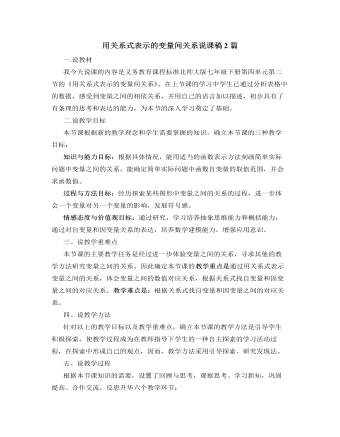
北师大版初中七年级数学下册用关系式表示的变量间关系说课稿2篇
一.说教材我今天说课的内容是义务教育课程标准北师大版七年级下册第四单元第二节的《用关系式表示的变量间关系》。在上节课的学习中学生已通过分析表格中的数据,感受到变量之间的相依关系,并用自己的语言加以描述,初步具有了有条理的思考和表达的能力,为本节的深入学习奠定了基础。二.说教学目标本节课根据新的教学理念和学生需要掌握的知识,确立本节课的三种教学目标:知识与能力目标:根据具体情况,能用适当的函数表示方法刻画简单实际问题中变量之间的关系,能确定简单实际问题中函数自变量的取值范围,并会求函数值。过程与方法目标:经历探索某些图形中变量之间的关系的过程,进一步体会一个变量对另一个变量的影响,发展符号感。情感态度与价值观目标:通过研究,学习培养抽象思维能力和概括能力,通过对自变量和因变量关系的表达,培养数学建模能力,增强应用意识。
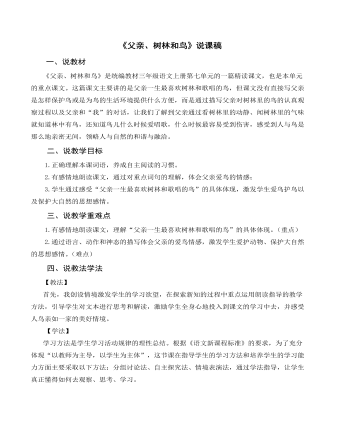
部编人教版三年级上册《父亲、树林和鸟》说课稿
二、说教学目标1.正确理解本课词语,养成自主阅读的习惯。2.有感情地朗读课文,通过对重点词句的理解,体会父亲爱鸟的情感;3.学生通过感受“父亲一生最喜欢树林和歌唱的鸟”的具体体现,激发学生爱鸟护鸟以及保护大自然的思想感情。三、说教学重难点1.有感情地朗读课文,理解“父亲一生最喜欢树林和歌唱的鸟”的具体体现。(重点)2.通过语言、动作和神态的描写体会父亲的爱鸟情感,激发学生爱护动物、保护大自然的思想感情。(难点)四、说教法学法【教法】首先,我创设情境激发学生的学习欲望,在探索新知的过程中重点运用朗读指导的教学方法,引导学生对文本进行思考和解读,激励学生全身心地投入到课文的学习中去,并感受人鸟亲如一家的美好情境。【学法】学习方法是学生学习活动规律的理性总结。根据《语文新课程标准》的要求,为了充分体现“以教师为主导,以学生为主体”,这节课在指导学生的学习方法和培养学生的学习能力方面主要采取以下方法:分组讨论法、自主探究法、情境表演法,通过学法指导,让学生真正懂得如何去观察、思考、学习。
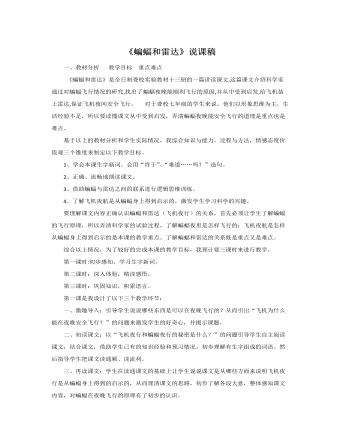
(新)部编人教版四年级上册《 蝙蝠和雷达》说课稿
一、激趣导入:引导学生说说哪些东西是可以在夜晚飞行的?从而引出“飞机为什么能在夜晚安全飞行?”的问题来激发学生的好奇心,并揭示课题。二、初读课文:以“飞机夜行和蝙蝠夜行的秘密是什么?”的问题引导学生自主阅读课文,结合课文,借助学生已有的知识经验和预习情况,初步理解有生字组成的词语。然后指导学生把课文读通顺、读流利。三、再读课文:学生在读通课文的基础上让学生说说课文是从哪些方面来说明飞机夜行是从蝙蝠身上得到的启示的,从而理清课文的思路,初步了解各段大意,整体感知课文内容,对蝙蝠在夜晚飞行的原理有了初步的认识。接下来我重点讲讲第二课时的教学设计。这一课的 教学中,我将以设疑悬疑──悟疑解疑──创造性思维训练,这种教学思路引导下,使学生充分发挥自己的主体作用,学生的积极性、主动性得到了充分的施展。学生不仅读懂了课文,认识也逐步加深。通过以下几个教学环节来完成教学任务。
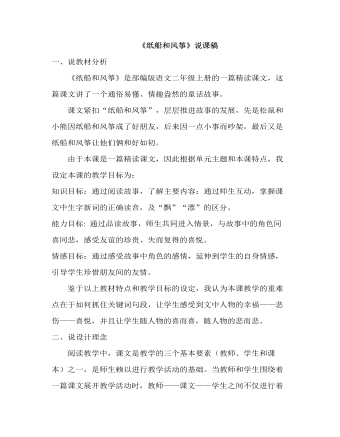
部编人教版二年级上册《纸船和风筝》说课稿
一、说教材分析《纸船和风筝》是部编版语文二年级上册的一篇精读课文,这篇课文讲了一个通俗易懂、情趣盎然的童话故事。课文紧扣“纸船和风筝”,层层推进故事的发展,先是松鼠和小熊因纸船和风筝成了好朋友,后来因一点小事而吵架,最后又是纸船和风筝让他们俩和好如初。由于本课是一篇精读课文,因此根据单元主题和本课特点,我设定本课的教学目标为:知识目标:通过阅读故事,了解主要内容:通过师生互动,掌握课文中生字新词的正确读音,及“飘”“漂”的区分。能力目标: 通过品读故事,师生共同进入情景,与故事中的角色同喜同悲,感受友谊的珍贵、失而复得的喜悦。情感目标:通过感受故事中角色的感情,延伸到学生的自身情感,引导学生珍惜朋友间的友情。鉴于以上教材特点和教学目标的设定,我认为本课教学的重难点在于如何抓住关键词句段,让学生感受到文中人物的幸福——悲伤——喜悦,并且让学生随人物的喜而喜,随人物的悲而悲。
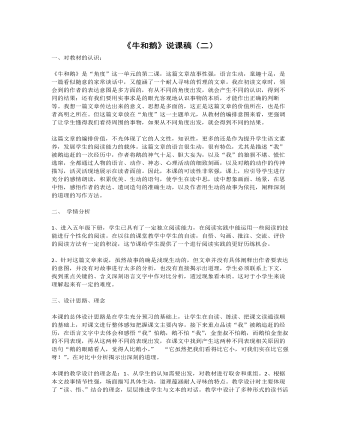
(新)部编人教版四年级上册《 牛和鹅》说课稿(二)
这篇文章的编排价值,不光体现了它的人文性,知识性,更多的还是作为提升学生语文素养,发展学生的阅读能力的载体。这篇文章的语言很生动,很有特色,尤其是描述“我”被鹅追赶的一次经历中,作者将鹅的神气十足、胆大妄为,以及“我”的狼狈不堪、慌忙逃窜,全都通过人物的语言、动作、神态、心理活动的细致刻画,以及对鹅的动作的传神描写,活灵活现地展示在读者面前。因此,本课的可读性非常强,课上,应引导学生进行充分的感情朗读,积累优美、生动的语句,使学生在读中思,读中想象画面、场景,在思中悟,感悟作者的表达、遣词造句的准确生动,以及作者用生动的故事为依托,阐释深刻的道理的写作方法。二、 学情分析1、进入五年级下册,学生已具有了一定独立阅读能力,在阅读实践中能运用一些阅读的技能进行个性化的阅读。在以往的课堂教学中学生的自读,自悟、勾画、批注、交流、评价的阅读方法有一定的积淀,这节课给学生提供了一个进行阅读实践的更好历练机会。2、针对这篇文章来说,虽然故事的确是浅现生动的,但文章并没有具体阐释出作者要表达的意图,并没有对故事进行太多的分析,也没有直接揭示出道理,学生必须联系上下文,找到重点关键的、含义深刻语言文字中作对比分析,透过现象看本质。这对于小学生来说理解起来有一定的难度。

部编人教版六年级上册《三黑和土地》说课稿
一、说教材 《三黑和土地》是统编教材小学语文六年级上册第六单元的一篇略读课文。这是一首现代诗歌,描述了翻身农民三黑重获土地的喜悦心情,对土地的无比热爱之情,以及有了土地后对美好生活的憧憬和向往。 本文分为三个部分:第一部分总体写出三黑得到土地后,视若珍宝、爱不释手的情感。认真地侍弄土地:仔细地翻地,来回地耙地,把土地弄得非常松散,简直像一张柔软的床。非常适合种子在上面生长。第二部分介绍三黑把荞麦种子播种到地里,看到麦苗的良好长势,听到地里的蝈蝈叫,想起心酸的童年生活,第三部分,展望未来,向往美好的生活。 二、说教学目标 1.训练学生正确理解和运用语言文字的能力。 2.掌握作者比喻的修辞手法。 3.了解三黑对土地的热爱和对美好生活的向往之情。

人音版小学音乐一年级上玩具兵进行曲说课稿
这就充分说明了别看低年级孩子年龄小,但相信只要通过仔细聆听,认真思考,低年级学生在他们的层面上也完全有能力感悟音乐的内涵所在。最后在孩子们充分发挥想象力后,教师再简单地揭示本课的主题以及作者和创作背景,尽可能地为每一位学生搭建一个展现自我风采的舞台。在感知《玩具兵进行曲》的基础上,再以 " 优化学习的方式,进行教学反馈。 " 让学生亲自体验创作运用多种不同的形式(如:合唱分组、舞蹈表演、乐器演奏等形式)对歌曲《玩具进行曲》进行分组表演的乐趣。在表现 " 玩具木偶 " 愉悦心情的同时,通过生生互动、师生互动、略带游玩式的教学形式,以次来培养学生对音乐的兴趣,把课堂又推向一个新的高潮。本课的设计力求能引起学生学习音乐的愿望,强化审美体验,给学生带来愉悦的教学方法。当然课的设计还存在着许多的不足,设计者渴望得到各位专家和老师的指点与帮助。同时希望引起对此问题的共同探究和研究,摸索出一套行之有效的教学方法。
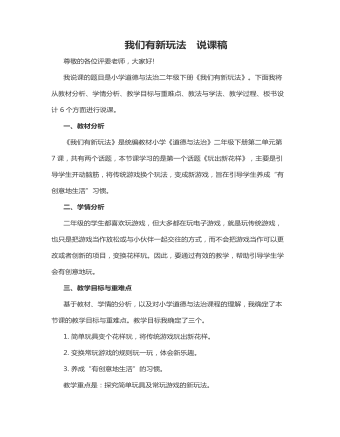
我们有新玩法 说课稿
尊敬的各位评委老师,大家好!我说课的题目是小学道德与法治二年级下册《我们有新玩法》。下面我将从教材分析、学情分析、教学目标与重难点、教法与学法、教学过程、板书设计6个方面进行说课。一、教材分析《我们有新玩法》是统编教材小学《道德与法治》二年级下册第二单元第7课,共有两个话题,本节课学习的是第一个话题《玩出新花样》,主要是引导学生开动脑筋,将传统游戏换个玩法,变成新游戏,旨在引导学生养成“有创意地生活”习惯。二、学情分析二年级的学生都喜欢玩游戏,但大多都在玩电子游戏,就是玩传统游戏,也只是把游戏当作放松或与小伙伴一起交往的方式,而不会把游戏当作可以更改或者创新的项目,变换花样玩。因此,要通过有效的教学,帮助引导学生学会有创意地玩。三、教学目标与重难点基于教材、学情的分析,以及对小学道德与法治课程的理解,我确定了本节课的教学目标与重难点。教学目标我确定了三个。1. 简单玩具变个花样玩,将传统游戏玩出新花样。2. 变换常玩游戏的规则玩一玩,体会新乐趣。3. 养成“有创意地生活”的习惯。
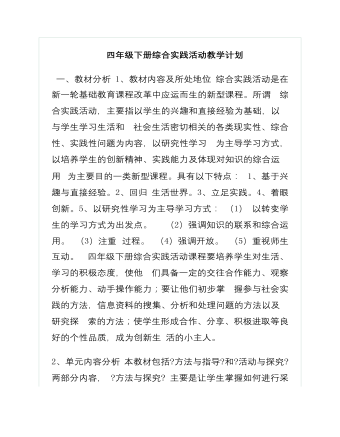
四年级下册综合实践活动教学计划及教案
一、教材分析 1、教材内容及所处地位综合实践活动是在新一轮基础教育课程改革中应运而生的新型课程。所谓综合实践活动,主要指以学生的兴趣和直接经验为基础,以与学生学习生活和社会生活密切相关的各类现实性、综合性、实践性问题为内容,以研究性学习为主导学习方式,以培养学生的创新精神、实践能力及体现对知识的综合运用为主要目的一类新型课程。具有以下特点: 1、基于兴趣与直接经验。2、回归生活世界。3、立足实践。4、着眼创新。5、以研究性学习为主导学习方式:(1)以转变学生的学习方式为出发点。(2)强调知识的联系和综合运用。(3)注重过程。(4)强调开放。(5)重视师生互动。四年级下册综合实践活动课程要培养学生对生活、学习的积极态度,使他们具备一定的交往合作能力、观察分析能力、动手操作能力;要让他们初步掌握参与社会实践的方法,信息资料的搜集、分析和处理问题的方法以及研究探索的方法;使学生形成合作、分享、积极进取等良好的个性品质,成为创新生活的小主人。2、单元内容分析本教材包括?方法与指导?和?活动与探究?两部分内容, ?方法与探究? 主要是让学生掌握如何进行采访,通过一系列活动,掌握采访的准备、注意事项、具体实施,及最后的交流总结,培养学生交往能力。 ?活动与探究?包括六个主题,主题一我们身边的标志,通过让学生认识标志,体会含义。学会分类,最后学会制作标志,循序渐进,蕴含了创新、守规、审美等能力的培养;主题二早餐与健康通过谈论,调查、分析讨论培养学生交流总结能力,树立健康生活意识;主题三,有趣的丝网花,通过制作培养学生合作、审美、动手能力;主题四巧手做风筝继续对学生进行培养;主题五植物的扦插与嫁接,与现实生活联系密切,通过活动掌握方法,体验快乐,体验劳动的乐趣;主题六争做小小志愿者,通过了解体验志愿者的活动,丰富阅历,培养学生的服务意识,自身获得提升与发展。教材的重点、难点:重点:学会交流,提升能力;认识各种标志,学会制作;学会健康的生活;通过制作丝网花、风筝、植物的扦插于嫁接,学会制作,提高动手能力,通过体验小小志愿者,提高服务意识。难点:教学中让学生亲身参与、主动实践,在实践中综合运用所学知识解决各种实际问题,提高解决实际问题的能力。学习基础:四年级学生已具备了一定的实践能力,因此要逐步培养学生一些探究问题的方法,提高学生的动手意识,能够从生活和学习中挖掘自己感兴趣的活动主题,能够试着和同学展开小组合作学习,在有效的活动中不断提高学生的动手与创新的潜能。

